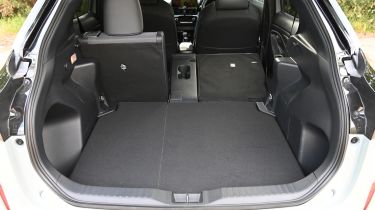Toyota Yaris Cross - Boot space, comfort & practicality
Although the Toyota Yaris Cross offers more space than the regular Yaris supermini, other small SUV rivals are more practical

The Toyota Yaris Cross is taller and rides higher than the Toyota Yaris hybrid supermini it shares its underpinnings with, giving the raised driving position many drivers like. It’s a five-seat small SUV, although three across the back seat will be a squeeze and there isn’t a great deal of rear leg room for those travelling in the second row.
Slightly unusually, seatback pockets and underfloor boot storage are only standard on Excel trim and above, and if you want cupholders in the back, you have to upgrade to the Design trim level.
| Dimensions | |
| Length | 4,172mm |
| Width | 1,765mm |
| Height | 1,595mm |
| Number of seats | 5 |
| Boot space | 460-1097-litres (401-1097-litres AWD) |
Dimensions and size
At 4,180mm long, the Toyota Yaris Cross is 240mm longer than its supermini sibling, but the 2,560mm wheelbase is the same for both. They’re similar widths, too, with the Yaris Cross measuring 1,765mm wide, but the compact SUV stands 1,595mm tall – 95mm taller than the regular Yaris.
To get a sense of how the Yaris Cross sizes up compared to its close rivals, the Ford Puma is a little longer and wider, although it has a lower roofline, while the Renault Captur is the longest of the three and sits between the Yaris Cross and Puma in terms of overall width and height.
How practical is the Toyota Yaris Cross?
Seats & space in the front
The front seats in the Toyota Yaris Cross offer good support, while standard kit such as a central armrest, a reach and rake-adjustable steering wheel and front cup holders help to make things more comfortable. Step up to mid-range Design trim, and you get electrically adjustable lumbar support – a rarity in this class.
Used - available now

2025 Toyota
Yaris Cross
34,965 milesAutomaticPetrol1.5L
Cash £19,499
2025 Toyota
Yaris Cross
31,993 milesAutomaticPetrol1.5L
Cash £19,748
2025 Toyota
Yaris Cross
14,817 milesAutomaticPetrol1.5L
Cash £20,235
2025 Toyota
Yaris Cross
34,261 milesAutomaticPetrol1.5L
Cash £18,588Storage could be better, with the Cross featuring a relatively small boot and little space to keep odds and ends secure in the cabin. The fabric parcel shelf looks cheap, and adds to the feeling that Toyota approached its small SUV with cost-savings firmly in mind.
Seats & space in the back
The rear bench in the Yaris Cross offers enough headroom for anyone around six foot tall, but legroom is in relatively short supply, so taller teenagers and adults probably won’t want to spend much time in the back of the Yaris Cross. They’ll also be disappointed by the lack of any USB charging ports, and access is compromised due to the small rear doors.
There are two sets of ISOFIX child seat mounting points in the back of the Yaris Cross, however, the small door openings and limited space will make it difficult to accommodate bulky child seats.
Boot space
The front-wheel drive Toyota Yaris Cross provides 397 litres of luggage space up to the tonneau cover versus the all-wheel drive version’s 320 litres. Fold the rear seats down, and the load volume expands to 1,097 litres. It’s worth noting that entry-level Icon cars get a 60:40 split-folding rear bench, while all others get seats that split 40:20:40.
More expensive models (Excel and above) include a false boot floor that can create a flush load area with the load lip and folded back seats. That’s pretty handy because the Yaris Cross has a hefty lip to try and get heavier items over. It’s a shame you can’t add this as a reasonably priced option on other trims, because an adjustable height boot floor is something that’s standard on the Volkswagen T-Cross.
Rivals have the Yaris Cross beat in this area, with the Ford Puma offering 456 litres of boot space, while the Dacia Duster boasts a 517 litres. The Renault Captur also provides 422 litres as standard, but the ace up its sleeve is its sliding rear bench, meaning you can push capacity to 536 litres when needed.
Towing
Towing capacity is nothing to write home about because no version can lug around more than a 750kg braked trailer, making the 13-pin tow bar option a bit pointless. A Kona Hybrid can haul up to 1,300kg, while dedicated caravan types must go for the four-wheel drive ‘4Motion’ VW T-Roc. That can tow up to 1700kg in both 2.0-litre petrol and diesel forms.












